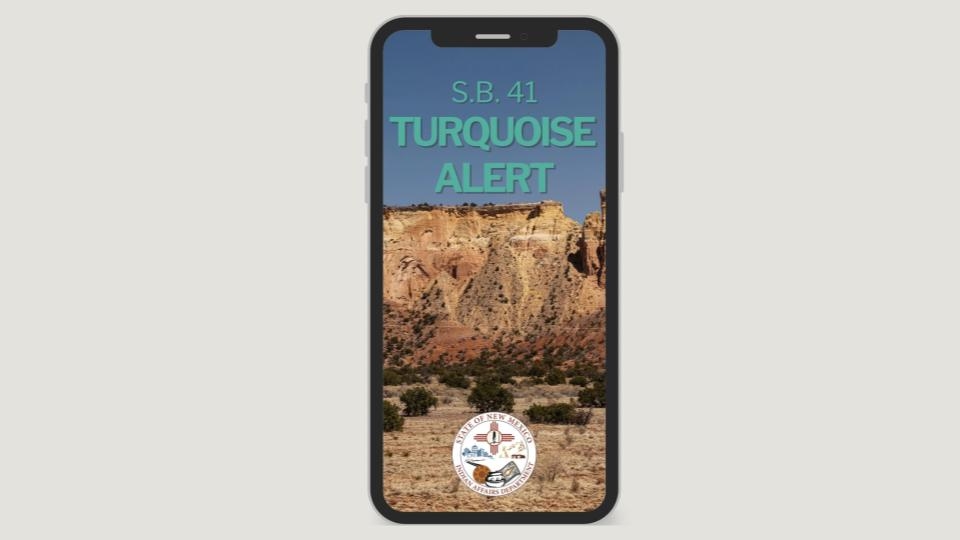Podcast: Play in new window | Download | Embed
New Mexico joins three other states that have now created an alert system for missing Indigenous people.
The bill unanimously passed both chambers on Friday and now heads to Gov. Michelle Lujan Grisham (D-NM).
Reporter Jeanette DeDios (Jicarilla Apache and Diné) has the details.
The Turquoise Alert system will allow law enforcement to quickly share information about missing Indigenous people through news media, social networks, and digital highway signs without having to wait the standard 48 hours.
According to the New Mexico Department of Justice, there are about 200 missing Indigenous people in the state.
The bill’s sponsor, State Sen. Angel Charley (Laguna Pueblo and Diné/D-NM), shared the news on Instagram and said the system is not a tribal mandate, but will instead go through the Department of Public Safety.
“It’s not going to fix our jurisdictional complexity issues, but it is going to ensure that when a Native person goes missing, that there’s an immediate, rapid response.”
The alert system will coordinate with state law enforcement agencies, tribal communities, and state resources when a missing Indigenous person goes missing in order to provide quick action and public awareness.
The governor has 20 days after the session ends to sign this bill into law and would take effect July 1.
 The number of Alaska Native language speakers has been declining over the years including speakers of Alutiiq.
The number of Alaska Native language speakers has been declining over the years including speakers of Alutiiq.
But a new language class that’s live streamed from the Kodiak Archipelago community of Port Lions aims to combat that trend locally.
KMXT’s Davis Hovey reports.
“Cama’I, Quyanaa, Taylugee, and welcome. Thank you for coming to another episode of King’s Corner.”
Every Thursday students from the school in the Native Village of Port Lions discuss Alutiiq culture and language. That’s in preparation for class lessons and conversations in Alutiiq that are live streamed online twice a month.
It’s the Port Lions’ students’ first time speaking their Native language within school through the Alutiiq Culture class. That includes practicing everything from weather reports to animals and place names in Alutiiq.
Jess Eggemeyer II, who works for the Native Village of Port Lions, teaches the class.
“I really saw a need for content that was focused on the local community and that would include current events happening in the village and at the school. A local safety bulletin, the weather forecast, as you’ve seen.”
Eggemeyer says the livestream, which is called Kings Corner after the school’s mascot, is a product of Elders and the previous generation laying the groundwork for language revitalization in Port Lions and around Kodiak Island.
That multi-year-long effort by multiple organizations and individuals has led to Alutiiq textbooks, digital audio recordings of Native speakers, and language courses for college students or even adults.
“If we don’t teach our children now, this is how languages die and it’s unfortunately not uncommon.”
Alaska Native languages in general are at risk of being lost or going extinct as Elders who speak the language are passing on. For Koniag or Kodiak Alutiiq, which is the dialect mainly spoken in the Kodiak Archipelago, less than 20 fluent first language speakers are still alive today.
Eggemeyer says the class will go through the rest of this semester and he hopes to continue it this summer and next school year too.
“(Sign off from show) tang’rciqamken (I’ll see you again in Alutiiq)”
 The U.S. Postal Service is hosting a first-day-of-issue ceremony for its Forever stamps celebrating powwows.
The U.S. Postal Service is hosting a first-day-of-issue ceremony for its Forever stamps celebrating powwows.
Four stamps showcase paintings of Native dancers by Cochiti Pueblo artist Mateo Romero.
They feature Women’s Traditional Dance, Crow Hop Dance, Men’s Hoop Dance, and Women’s Fancy Shawl Dance.
The ceremony will be held at the Gathering of Nations Pow Wow in April in Albuquerque, N.M.
Get National Native News delivered to your inbox daily. Sign up for our daily newsletter today.



